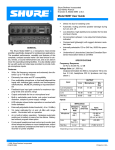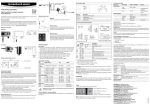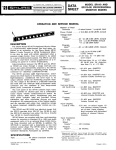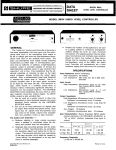Download Shure HTS5000 Specifications
Transcript
2 2 2 HARTREY AVE., EVANSTON. IL. 6 0 2 0 4 U.S.A. MICROPHONES AND ELECTRONIC COMPONENTS AREA CODE 3121866-2200 TWX: 9 1 0 - 2 3 1 - 0 0 4 8 MODEL HF52 CABLE: SHUREMICRO TELEX: 72.4381 MOBILE VOICE PICKUP SYSTEM GENERAL The Shure Model HF52 Mobile Voice Pickup System is a dynamic unit designed specifically for "handsfree" operation in a variety of mobile applications, including police, taxicab, and other radio-dispatched vehicles. When properly installed, the HF52 will provide high-quality communications without the need for holding the microphone or hand-keying the transmitter. The HF52 is designed for use only on vehicles with 12-volt negative ground electrical systems. The HF52 consists of three assemblies: Model HF52M Microphone, Model HF52A Amplifier, and Model HF52S Footswitch. The microphone is supplied with a mounting clip and a mounting bracket, both for use in attaching the microphone to the vehicle sun visor, and a cable for connecting to the amplifier. The amplifier, which has an adjustable gain control for use with a variety of mobile transmitters, is supplied with two screws for attachment to the vehicle, and cables for connection to the transmitter audio input and the vehicle 12 Vdc power. The weatherproofed normally open, single pole footswitch is supplied with a permanently mounted cable for connection to the transmitter, and two screws for mounting to the vehicle floor. A kit of cable clamps, clips and ties is provided to secure the cables. Features: = . . = . Convenient, hands-free operation under all conditions Omnidirectional pickup pattern for uniform sound output over wide range of microphone locations Communications-type frequency response for maximum intelligibility Amplifier suitable for use with most mobile transmitterinputsdesigned for ceramic, high-impeddynamic Or 'ONTROLLED carbon or transistorized microphones Amplifier gain is adjustable for microphone distance and transmitter sensitivity Virtually unaffected by RF fields and power supply fluctuations and noise Operable over wide temperature and humidity range Rugged withstands shock and vibration INSTALLATION Before installing the HF52, place the amplifier and footswitch in their approximate desired positions. Determine whether connecting cables are of proper length, and cut or splice them as required. If feasible, connect the amplifier output cable and footswitch cable to the transmitter input connector before installing the amplifier and footswitch. Copyright 1981, Shure Brothers 27A1659 (UC) Amplifier Install the HF52A Amplifier as follows: 1. Verify that vehicle battery is 12-volt negative ground! i.e., negative battery cable is connected to vehicle frame. 2. Select mounting location for amplifier under dashboard or on firewall, preferably left of steering column. Make certain location does not interfere with any vehicle control functions Or service access. 3. Drill two holes (#29-0.136 in.) spaced 108 mm (4Y4 in.) apart, and mount amplifier using two pan head screws supplied. NOTE: Make sure screws attach to metal surface to provide chassis ground contact. Be certain that access to gain control in amplifier (covered by hole plug-see Figure 7) is maintained. Also make certain that there is sufficient clearance to allow insertion and removal of microphone and output cable C~~-~nectors. 4. Connect red power cable with in-line fuse to suitable 12-volt positive power SOUrCe. Source must be controlled by ignition or transmitter power switch, as HF52 does not contain its own power switch. Secure power cable with cable clamps and screws (#32-0.116 in. drill) or cable clips. 5. Connect amplifier output cable and route to area of transmitter audio input. Secure amplifier output cable with cable clamps and screws or cable clips. Microphone The HF52M is an omnidirectional unit, receiving sound equally from all directions. As such, it may be mounted almost anywhere in the vehicle. However, for maximum sound pressure and minimum outside noise pickup, i t should be located as close to the operator's mouth as possible. A recommended method of installing the HF52M is as follows: 1. Select mounting clip or mounting bracket and attach it to vehicle sun visor. Figure 1 shows mounting bracket attachment and Figure 2 shows mounting clip attachment. Note that either mounting device should be positioned at top of visor and away from driver when visor is in "up" position. Inc. Printed i n U.S.A. I 2. Snap microphone into mounting clip or bracket. Microphone should face roof of vehicle with visor in "up" position. When visor is moved down, microphone on visor faces downward. MICROPHONE IN MOUNTING BRACKET FIGURE 1 MICROPHONE IN MOUNTING CLIP FIGURE 2 3. Secure microphone cable at visor hinge using cable tie. 4. Route cable down between driver's door and windshield to amplifier. NOTE: Variations in vehicle design make it. necessary for the installer to decide the best method of routing the cable. Cable clamps and screws (#32-0.116 in. drill) are provided to secure cable. 5. Connect microphone to amplifier. On some vehicles, it may be desirable to mount the microphone on the steering column. When this mounting method is appropriate, secure the mounting bracket with a strong rubber band passed around the steering column and hooked to both sides of the microphone clasp on the mounting bracket. The clasp should be rotated on the bracket so that the microphone faces the vehicle operator. Route and secure the cable conveniently as described in step 4 above. Connect the microphone to the amplifier. Footswitch Install the HF52S Footswitch as follows: 1. Locate footswitch on floorboard in an area that will permit easy access when operated by driver's left foot. For vehicles with automatic transmissions, optimum location is to left and slightly above brake pedal. 2. Drill two holes (#29-0.136 in.) spaced 76.2 mm (3 in.) apart, and attach footswitch to floorboard using two pan head screws supplied. 3. Run footswitch cable to area of transmitter audio input. Secure footswitch cable with cable clamps and screws (#32-0.116 in. drill) or cable clips. Transmitter Connections Obtain an input connector for the transmitter to be used, and wire the amplifier output leads to the transmitter audio input (shield to ground). Wire the footswitch (normally open) leads across the transmitter keying circuit. Note that the footswitch is not directly connected to the amplifier. Adjustments Remove the hole plug covering the amplifier gain control (see Figure 7). With a small screwdriver, turn the amplifier gain control fully counterclockwise. Start the engine and key the transmitter while sitting in the driving position and talking at a normal level. Advance the amplifier gain control until proper transmitter modulation is obtained. To avoid excessive noise pickup, do not set the gain control higher than necessary for full voice modulation. Replace the hole plug. Low- and High-Frequency Rolloff The normal frequency response of the HF52A Amplifier is shown in curves 4-5 of Figure 6. The low-frequency rolloff characteristic shown provides optimum intelligibility under conditions of high background noise. When background noise is not a problem, the amount of low-frequency rolloff can be reduced as shown in curves 1-3. The low- and high-frequency rolloff characteristics of the Amplifier may be changed as shown in curves 1-3 and 6-8 of the figure by a simple capacitor substitution as follows. Remove the Amplifier cover by removing the four screws securing it to the box. To change the lowfrequency rolloff, place a 25 Vdc minimum capacitor across terminals A and J of the printed circuit board: Curve 1: ,068 pF Curve 2: .027 pF Curve 3: .O1 pF Curve 4: none (as supplied) Restricting the high-frequency response may also, under some conditions, reduce the effect of background noise. To change the high-frequency rolloff, solder a capacitor (25 Vdc minimum) of the following value across printed circuit board terminals G and H (placing this value in parallel with capacitor C3): Curve 5: none (as supplied) Curve 6: .0015 pF Curve 7: .0047 pF Curve 8: .O1 pF Replace and secure the Amplifier cover. NOTE: The resultant system response (microphone and amplifier) is shown in Figure 8. OPERATION The HF52M Microphone is an omnidirectional unit, designed for minimum wind and vibration pickup. When properly installed and adjusted, the HF52 system (microphone and amplifier) will provide approximately the same output level at approximately 46 cm (18 in.) as a "close-talked" communications microphone. The acoustical elements are designed to optimize performance in the frequency range of 200 to 5,000 Hz. This results in the substantial reduction of sounds outside the desired range. Because the microphone is located at a distance from the operator, its output is relatively low and requires amplification. The required gain is supplied by the HF52A Amplifier. Therefore, all sounds of sufficiently high level and within the microphone frequency range will be transmitted. This means that the operator should be as close as possible to the microphone for maximum voice pickup and minimum noise pickup. However, it is not necessary for the microphone to be pointed at the operator; any microphone orientation is satisfactory, as long as the microphone is as close as possible to the operator. Dimensions: See Figure 5 The operator can help provide good commun~cations by remembering these factors: 1. Keep vehicle windows closed to minimize outside noise while transmitting. 2. Bear in mind that passenger conversation or other in-vehicle noise (radio, air conditioner, etc.) will be transmitted. 3. Remember that higher vehicle speeds mean higher background vehicle noise. .. 4. As with any communications system, care in speaking clearly will promote intelligible communication. ( 7 2 IN.) MICROPHONE OVERALL DIMENSIONS FIGURE 5 SPECIFICATIONS Net Weight: MICROPHONE Type: Dynamic 98 grams (3% oz) Frequency Response: 200 to 5,000 Hz (see Figure 3) AMPLIFIER Voltage Gain (at 1,000 Hz): Adjustable, 38 to 59 dB - Frequency Response: 200 to 10,000 Hz as shown in curve 4-5 of Figure 6 d +I0 W $ O W 5 -10 L 20 lpO0 lO.000 24000 FREQUENCY IN HERTZ TYPICAL FREQUENCY RESPONSE FIGURE 3 Microphone Impedance: 190 ohms at 1 kHz Output Level (at 1,000 Hz): Open circuit voltage (without amplifier) . . . . . . . . . . -79.0 dB (0 dB = 1 volt per microbar) Power Level . . . . . . . . . . . . . . . . - 58.0 dB (0 dB = 1 milliwatt per 10 microbars) AMPLIFIER FREQUENCY RESPONSE FIGURE 6 Output Clipping Level: 1V min. (100-ohm output termination) Recommended Load Impedance: 100 ohms min. (superimposed dc voltage up to 16V will not affect operation) Phasing: Positive pressure on diaphragm produces positive voltage on pin 2 of connector (see Figure 4) CODED TERMINAL / Output Impedance: Less than 10 ohms Phasing: Output is out of phase with input Noise (300 Hz - 20 kHz): - 118 dBV (equivalent input noise at full gain) & MICROPHONE WIRING DIAGRAM FIGURE 4 Total Harmonic Distortion (at 1,000 Hz): 3% max. at 500 mV output "I Current Drain: 15 mA max. (no signal) 25 mA max. (100-ohm load, 750 mV output) Operating Conditions: Temperature . . . -40" to +74"C (-40" to +165"F) Relative Humidity . . . . . . . . . . . . . . . . . . . . .5 to 95% Operating Voltage: ground Cable: Non-detachable 1.8m (70 in.) two-conductor shielded plastic-jacketed cable * to + I 5 9 Vdc, negative Fuse: 5A, 32V, 3AG Connector: Two-pin male miniature audio* Finish: + 10.0 Operating Temperature Range: -29" to +74"C (-20" to 165°F) Dark gray Designed to mate with Switchcraft "Slim Line II" or equivalent connector. Dimensions: See Figure 7 3 AMPLIFIER OVERALL DIMENSIONS FIGURE 7 Net Weight: Finish: 323 grams (111/2 oz) Dark gray SYSTEM Frequency Response: 200 to 5,000 Hz (see Figure 8) MICROPHONE CARTRIDGE AND CABLE REPLACEMENT To remove and replace the HF52M Microphone cartridge or cable and plug assembly, proceed as follows: 1. Using pliers or wrench, remove bushing at rear of microphone. 2. Without allowing cable to turn, unscrew end cap of microphone, exposing cablelcartridge connections. 3. Using spanner wrench or similar tool, unscrew brass retainer bushing from inside case. 4. Carefully slide cartridge and attached cable out of case. 5. Unsolder cartridge from cable. 6. Replace cartridge by soldering cable to new cartridge (see Figure 4). 7. Replace cable by slipping bushing, end cap and retainer bushing over new cable, and soldering new cable to cartridge (see Figure 4). 8. Reassemble microphone by performing steps 1 through 4 in reverse. REPLACEMENT PARTS The following replacement parts may be ordered from your dealer or from Shure Brothers Inc. DESCRIPTION SYSTEM FREQUENCY RESPONSE FIGURE 8 Output Level (at 1,000 Hz): Open Circuit Voltage . . . .Variable, -43 to -21 dB (0 dB = 1 volt per microbar) Combined Net Weight: 835 grams (1 Ib, 13 oz) PART NO. Microphone ................. 97A297 (HF52M) Microphone Cartridge ............ .99A367 Microphone Cable & Connector ... .90A2573 Amplifier . . . . . . . . . . . . . . . . . . .90A2707 (HF52A) Gain Control Hole Plug ...........80A289A Amplifier Cover . . . . . . . . . . . . . . . . . . .95A833 Amplifier Output Cable . . . . . . . . . . . .95C453 Footswitch . . . . . . . . . . . . . . . . .90A2240 (H F52S) A Parts List for the HF52A Amplifier is given on a following page. The commercial alternates shown in the list are not necessarily equivalent parts, but are electrically and mechanically similar, and may be used if direct factory replacements are not immediately available. To maintain highest possible performance and reliability, Shure Factory Replacement Parts should be used. GUARANTEE This Shure product is guaranteed in normal use to be free from electrical and mechanical defects for a period of one year from date of purchase. Please retain proof of purchase date. This guarantee includes all parts and labor. This guarantee is in lieu of any and all other guarantees or warranties, express or implied, and there shall be no recovery for any consequential or incidental damages. Packaged Weight: 1.13 kg (2 Ib, 71/2 oz) L II FOOTSWITCH DIMENSIONS FIGURE 9 SHIPPING INSTRUCTIONS Carefully repack the unit and return it prepaid to: Shure Brothers Incorporated Attention: Service Department 1501 West Shure Drive Arlington Heights, Illinois 60004 If outside the United States, return the unit to your dealer or Authorized Shure Service Center for repair. The unit will be returned to you prepaid. MODEL HF52A AMPLIFIER PRINTED CIRCUIT BOARD ASSEMBLY MODEL HF52A AMPLIFIER PARTS LIST Replacement Kit Consists Of: Reference Designation Replacement Kit No.* Qty. Part No. A1 - - 90A8048 D l , D2 - - 86A415 D3, D4 RKC21 4 86A404 D5 - - 86A421 D6 RKC22 1 86A408 F1 J1 J2 L1 - L4 Q1 Q2, Q3 Q4 Q5 Q6, Q7 Q8 R20 - - - RKC9 4 - - RKC66 RKC65 1 1 - - 90AZ2600 90AR2600 80A250 86C349 86A349 86A348 86A335 86A334 86A8303 46D033 Description Printed Circuit Board Assem bly Diode, Silicon, Computer, 75V Silicon Rectifier, 100V, 112A Zener Diode, Silicon, 8.7V +5%, 1/2W Zener Diode, Silicon, 22v *5%, 1W Fuse, 3AG, 5A, 32V Connector, Two-Socket Connector, Phono Pin Jack Ferrite Bead Ring Transistor, Silicon, NPN Transistor, Silicon, NPN Transistor, Silicon, NPN Transistor, Silicon, PNP Transistor, Silicon, NPN Transistor, Silicon, NPN Potentiometer, 100k 'Parts listed as RKC Kits should be ordered by that kit number. Any orders received for piece parts where RKC Kit number is shown will be shipped in RKC quantities. 5 Commercial Alternate None TI or GE IN4148 Motorola 1N4002 Motorola 1N5238B Motorola 1N4748A Littelfuse 311005 Switchcraft SL-17-2F Switchcraft 3501 FP Stackpole 57-01 81 Motorola 2N5210 Motorola 2N5088 Motorola 2N5087 TI TIS93 TI TIS92 Motorola 2N6121 CTS X201 R104B llfl3M13 9NIA3X tl3111WSNVMl 01 w X ' .AS 'S170A NI SUOISI=U n w .B NMOHS -.5310(U 3UlCUl33l3 C13UIZBdS 3SIMMtu.O cs a N v a j w NI s t c o ~ l s w d v 5n v 'I SITX 9jQLladW3 s m n 3aw ~EIUI-s 3SlMU3U.O S S ~ - I N.~ M*/I -%GI I A ~ W AAVW aNw 7 t 3 3 1 d ~3m =mwA ' SWHO 2 ~ t , N I a U W N I W W I C d h - 0 9 N W SWHO 051 WHL OU LCaNI I f l c U N j A u COS 33naobld QI C l 3 1 S 0 M W l M N l ZMHl aNW ( 3 5 1 ~ ~ ? 0 7 3 ~ l TN) N m W n W l N l W aL 135 WULNcn 1 3 A 3 WAJA S W H O 9 3 W 01 H l l M 0 3 t l n S W 3 W S 3 9 W l l O A ' 3 ' 0 .WAJ.A 3 W S W H 0 3 3 W 01 H l l M 0 3 B I E W O W S 3 3 W l l O A '3.W ' 3 9 W l 7 0 A A l d d S AO'ZI H l l M 0 3 t l f l S d 3 W 5 3 3 W l l O A 7 l W 'E '














